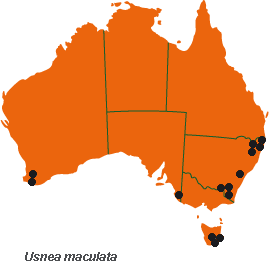



Australian Biological Resources Study
| Checklist of the Lichens of Australia and its Island Territories | ||
| Introduction | A–D | E–O | P–R | S–Z | Oceanic Islands | References | ||
| Usnea maculata Stirt. | ||
| Scott. Naturalist (Perth) 6: 293 (1882). T: Somerset, South Africa, P.MacOwan & J.H.McLea s.n.; lecto: BM, fide T.D.V.Swinscow & H.Krog, Norweg. J. Bot. 23: 27 (1976). | ||
| Thallus shrubby, erect, to 6 cm tall, variegated olive-green and red; branching subdichotomous, sparse to moderately dense; trunk black, cracked; branches terete, 0.5–1.0 mm wide, articulated at junction of branches, with annular cracks; apices blunt or tapered, sometimes blackened; branchlets numerous; fibrils numerous at base of primary branches; papillae absent or sparse. Isidia in pseudocyphellae only, dense, short, black-tipped; pseudocyphellae numerous, punctiform, rounded or coalescing; soralia absent. Cortex thick, dull or glossy, cracked. Medulla dense; axis 1/3 width of branch, hyaline. Apothecia not seen. CHEMISTRY: Cortex containing usnic acid. Medulla K–; containing protocetraric acid (major) and virensic acid (trace). |  |
|
| Occurs on rock in upland to montane areas of W.A., S.A., N.S.W., A.C.T. and Tas. Also in East Africa, South Africa and Madagascar. | ||
| Stevens (2004) | ||
| Checklist Index |
| Introduction | A–D | E–O | P–R | S–Z | Oceanic Islands | References |
This work is copyright. Apart from any use as permitted under the Copyright Act 1968, no part may be reproduced by any process without prior written permission from Australian Biological Resources Study. Requests and inquiries concerning reproduction and rights should be addressed in the first instance to Dr P. McCarthy. These pages may not be displayed on, or downloaded to, any other server without the express permission of ABRS.